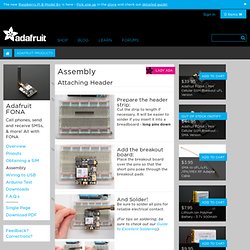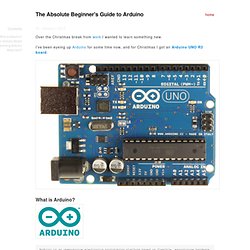

Sendi Dorra
Electronics : Microprocessors : I2C - Two-Wire Peripheral Interface - for Arduino. Tip A summary of everything shown below is available further down this page: This post describes how the I2C (Inter-Integrated Circuit, or "Two-Wire") interface works, with particular reference to the Arduino Uno which is based on the ATmega328P microprocessor chip.

A lot of the details however will be of more general interest. The Two-Wire interface is extremely useful for connecting multiple devices, as they can all share the same two pins (plus a ground return). This is because the devices are "addressable". Because of this you could have an LCD screen (say) at address 10, a keyboard at address 11, and so on. More information about I2C at: More information about the Arduino Two-Wire interface at: Other protocols Pinouts On the Arduino Uno the pins you need are: Analog port 4 (A4) = SDA (serial data)Analog port 5 (A5) = SCL (serial clock) On the Arduino Mega, SDA is digital pin 20 and SCL is digital pin 21 (they are marked SDA and SCL on the board itself).
Sending data Tip: ACK or NAK Timing Master. Arduino programming. Adafruit FONA. A battery and antenna is required!

If you have a uFL FONA, a uFL->SMA cable may be required to connect the antenna. Use any Lipoly or LiIon 3.7V/4.2V battery Check polarity for the battery! Snap the uFL connector on, it will click when placed properly You must insert a SIM card to do anything but the most basic tests. Adafruit Industries, Unique & fun DIY electronics and kits. A Showcase for MaKeyMaKey Creations. Category: Arduino. My older son recently started school and needed his own desk for doing homework. I wanted to make something nicer than a simple tabletop with legs, and realized that I could also build in a bit of fun for when the homework is finished. Both my boys and I still had space travel on our minds from our summer trip to Kennedy Space Center.
For this desk project, I decided to go with a NASA theme. I researched the Apollo Program as well as NASA's Mission Control Center, and designed my own console roughly based on those. I say "roughly" because the actual Mission Control does more monitoring than controlling, and isn't awash in the whiz-bang rocket noises young kids appreciate. The desk resides under my son's loft bed (which I also built), and stays closed until the homework is finished: When playtime begins, the lid flips up to reveal the Mission Control console: As I mentioned in the video, I painted the underside of the lid with magnetic primer.
Arduino Micro-controller. Download Archive - Symbol For Electronics. Top 40 Arduino Projects of the Web. Arduino Projects. The Absolute Beginner's Guide to Arduino. Over the Christmas break from work I wanted to learn something new.

I’ve been eyeing up Arduino for some time now, and for Christmas I got an Arduino UNO R3 board. What is Arduino? Arduino is an open-source electronics prototyping platform based on flexible, easy-to-use hardware and software. It's intended for artists, designers, hobbyists, and anyone interested in creating interactive objects or environments. Source: Microcontroller Arduino is a microcontroller on a circuit board which makes it easy to receive inputs and drive outputs. A microcontroller is a integrated computer on a chip. Inputs Some examples of inputs would be a temperature sensor, a motion sensor, a distance sensor, a switch and so forth.
Outputs Some examples of outputs would be a light, a screen, a motor and so forth. Arduino is a small computer that you can program to read and control electrical components connected to it. Obtaining an Arduino Board There are several online distributors that stock Arduino boards. The Code. The Absolute Beginner's Guide to Arduino. Micro Python - Python for microcontrollers.
VHDL Tutorial. Jan Van der Spiegel University of Pennsylvania Department of Electrical and Systems Engineering VHDL Tutorial 1 1.

Introduction. 1 2. 3. Behavioral model 5 Concurrency. 6 Structural description. 6 4. 5. Constant 11 Variable. 12 Signal 12 6.